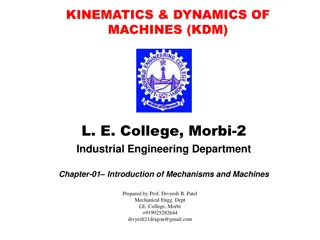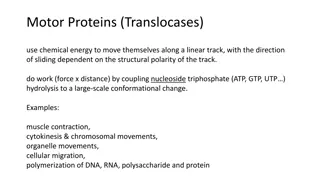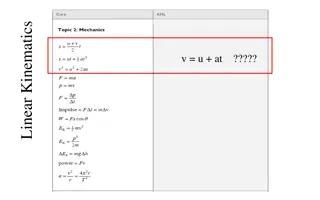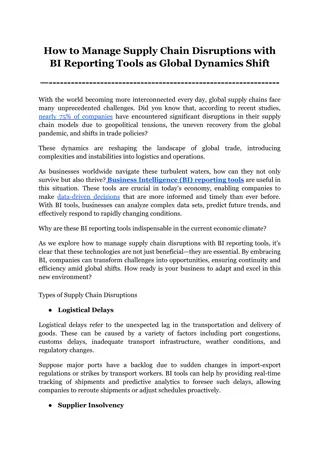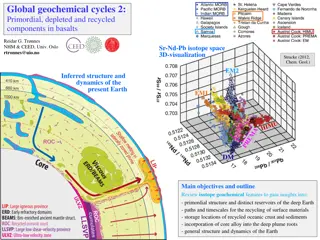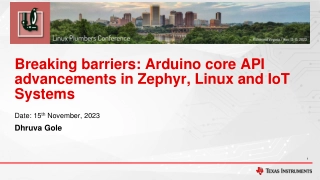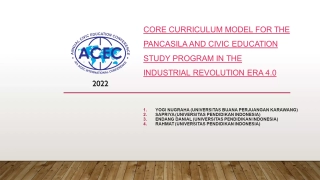Understanding Terrestrial Planets and Core Dynamics
Exploring the core-mantle interaction from the early Hadean period to present times reveals intriguing questions about the outer core's electrical conductivity, geodynamo sustainability, and inner core characteristics. Studies indicate challenges in maintaining the geodynamo, potential heat sources in the outer core, and the role of radioactivity in core composition. Researchers have suggested processes like exsolution of MgO and sulphide melt incorporation into the core metal. Understanding the metallic composition, melting curves of Fe, and solid phase relations offer valuable insights into the planetary cores' complex dynamics.
Understanding Terrestrial Planets and Core Dynamics
PowerPoint presentation about 'Understanding Terrestrial Planets and Core Dynamics'. This presentation describes the topic on Exploring the core-mantle interaction from the early Hadean period to present times reveals intriguing questions about the outer core's electrical conductivity, geodynamo sustainability, and inner core characteristics. Studies indicate challenges in maintaining the geodynamo, potential heat sources in the outer core, and the role of radioactivity in core composition. Researchers have suggested processes like exsolution of MgO and sulphide melt incorporation into the core metal. Understanding the metallic composition, melting curves of Fe, and solid phase relations offer valuable insights into the planetary cores' complex dynamics.. Download this presentation absolutely free.
Presentation Transcript
Terrestrial planets, the core situation
Current geodynamos Rotation periods and magnetic fields: Core fractions 58 days very weak 243 days extremely weak 24 hr strong 30 days very weak 5.3 hr 25 hr extr. weak
Core-mantle interaction early Hadean to present Outstanding questions Outer core electrical and thermal conductivity Indications of very high conductivity "problems" with: - the geodynamo (difficult to sustain) - age and size of the inner core Stagnant layer of light buoyant melt near the CMB Additional outer core heat sources? Radioactivity: K, but possibly also U U partitions to sulphide melt under very reducing conditions (corresponding to enstatite chondrites and to Mercury) Sulphide can merge into the core metal Exsolution of MgO from the core metal at CMB: exothermic process (MgO incorporation in bm and fp) - requires MgO incorporation in the core at very high T during MO-stage - counteracted by dissolution of FeO from bm and fp Selected references Pozzo et al. (2012, Nature) Helffrich & Kaneshima (2010, Nature) Wohlers & Wood (2015, Nature) Wahl & Militzer (2015, EPSL)
Bono et al. 2019, Nat. Geosci. Ediacaran Period
The rheology of the solid mantle imposes the convective and thermal regime of the core Mantle is the master - core is the slave (Dave Stevenson, Caltech)
Metals: Fe, Pt, Au, Ag, Cu Cubic close-packed CCP Face-centred cubic FCC Closest packing Coord. number: 12 CN: 12 g-Fe, taennite Pt, Au, Ag, Cu, Hexagonal close-packed HCP CN: 12 Mg, Zn, Cd Body-centred cubic BCC CN: 8 a-Fe, kamacite, ferrite
Fe: melting curves and solid phase relations - challenging experiments - still large uncertainties Outermost core Outermost core Li & Fei (2003, Treat. Geochem)
Fe: melting curves and solid phase relations - challenging experiments - still large uncertainties Is the inner core HP-bcc?? Probably not g a e Li & Fei (2003, Treat. Geoch.) Dubrovinski et al. (2007, Science) Tateno et al. (2010, Sci.) - hcp-Fe in the inner core - only 5100 K at 329 GPa (OC-IC-boundary) - must assume a low-T geotherm BUT: This is not specifically a melting study Two electronic structure computational studies (Stixrude 2012, Belonoshko et al. 2017) Stixrude (2012, PRL) Melt Belonoshko et al. 2017, Nat Geosci bcc-Fe in the inner core Probability density of atoms. Central atom shown as a small red sphere. OC: >4000 K g g e e 136 GPa CMB: a a
Experimental melting of Fe at core conditions Anzellini et al. 2013, Science Anzellini et al. 2013, Sci. Melting detected by: 1. Diffuse scattering and loss of XRD-peaks (in-situ, synchrotron-based XRD) 2. Temperature plateau 3. Volume plateau e-Fe g-Fe Anzellini et al. 2013, Sci.
Melting of Fe Anzellini et al. 2013, Science - Change/loss of XRD-peaks - Diffuse scattering T- and V plateaus
Melting of Fe: resistance heating Sinmyo et al. 2019, EPSL
Lunar core structure Weber et al. (2011, Science)
System Fe-S Brett & Bell (1969, EPSL) Chen et al. (2008, GRL) Fe wt% 90 80 90 80 Stewart et al. (2007, Science) Eutectic composition GPa wt% p Fe S 0 69 31 3 74 26 10 80 20 14 82 18 23 84 16 40 88 12
Stewart et al. (2007, Science) Mars: a "snowing" core? Eutectic composition 1 bar: 29 wt% S 3 GPa: 24 10 GPa: 20 14 GPa: 18 23 GPa: 17 40 GPa: 13 wt% S Mars core 100% liquid or constantly snowing
Liquidi, Fe-S alloys with 1-12 wt% S Mercury: also snowing core (?) Chen et al. (2008, GRL)
FeOmantle- core fraction Tr nnes et al. 2019, Tectonophysics
MESSENGER mission: New and partly surprising results from Mercury MESSENGER: MErcury Surface, Space ENvironment, GEochemistry and Ranging High S, in addition to low FeO very reduced condition during accretion (conditions similar to enstatite chondrite formation) McCubbin et al. (2012, GRL) Enstatite chondrite minerals like oldhamite (CaS), niningerite (MgS) and djerfisherite (alkali sulphide) are likely
Experimentally determined S-solubility in silicate melt 100 Inferred S-solubility in early Mercurian basalts: 1.5 4.0 wt% log 1.5 = 0.16 log 4.0 = 0.60 10 0.60 0.16 1 S-solubility wt% McCubbin et al. (2012, GRL) 0.1 -5 to -3 Very low fO2(O-content) High Fe0-content, Si partitions to the metal S-anions replace O in the silicate fraction Moderate to high fO2(O-content) Stabilises FeS-rich sulphides Chalcophile elements (incl. S) partition to metal
Trnnes et al. 2019, Tectonophysics Terrestrial planets: core and mantle compositions log fO2(DIW) = 2 * log (aFeO/aFe) Observations, explanations - Solar nebula zoning with increasing fO2outwards: Me Ve Ea Ma Vesta - Moon s tiny core and higher FeOmantle(12%) than Venus-Earth (6-8%) - Moon accreted mainly from Theia (+Earth) mantle debris - minor core core segregation at oxidising conditions at the post-GI stage
Core compositions Tr nnes et al. 2019, Tectonophysics Inner planets: Me-Ve-Ea Reduced: DIW < -2: Si-rich cores. Ve and esp. Ea: also O Outer bodies: Mo-Ma-Vesta and the Fe-meteorites Oxidised: DIW > -2: S-dominated cores
Trnnes et al. 2019, Tectonophysics System Fe-FeO-FeS, 1 bar -16 GPa with Fe/Ni=9 (right panels) System Fe-FeO, 1 bar, 16 GPa Kato & Ringwood, 1989, PCM 3073 K ionic liquid 2773 K metallic liquid 2273 K 1773 K 2473 K metallic liquid ionic liquid 2273 K 2073 K 1873 K
Trnnes et al. 2019, Tectonophysics Why do FeS-blobs exsolve from the Fe-rich melt? Immiscible FeS-drop. (troilite) Cape York (Agpalilik) iron meteorite (Slice at NHM, Univ. Oslo)
Trnnes et al. 2019, Tectonophysics Mercury - Extremely reduced - very large core fraction - FeS exsolution near the CMB (5.7 GPa) is likely - approach to 3-phase equilibrium (metal, sulphide and silicate melts) at the magma ocean stage The very high Sicoreand separate exsolved FeS(?) in Mercury reflect a very low O-content and O/S- ratio of the mantle and crust with minerals like niningerite, (Mg,Fe,Mn)S, and oldhamite, CaS, which are also present in enstatite chondrites.
Element partitioning between immiscible sulfide and silicate melts Kiseeva & Wood (2013, 2015, EPSL) Wohlers & Wood (2015, Nat; 2017, GCA) Wood & Kiseeva (2015, Am. Mineral.) Partitioning dependant on fS2and fO2: ZnO + 0.5 S2= ZnS + 0.5 O2 silicate sulfide K1= (aZnSsulf*fO20.5) / (aZnOsil*fS20.5) aZnSsulf / aZnOsil [Zn]sulf/ [Zn]sil= DZn DZn sulf/sil Experiments - 1.5 GPa, 1400 C, - variable fO2/ compositions sulf/sil= K'1* (fS2/fO2)0.5 Fugacities of S and O are difficult to quantify - therefore the equation: ZnO + FeS = FeO + ZnS silicate sulfide silicate sulfide K2= (aZnSsulf/aZnOsil)* (aFeOsil/aFeSsulf) DZn sulf/sil= K'2* aFeSsulf/aFeOsil Zn and other chalcophiles are trace elements in the FeS-dominated sulfide melt aFeSsulf 1 and: log DZn sulf/sil= K'2 - log aFeOsil Generally, for a trace element M with valency n: log DM sulf/sil constant - (n/2)* log[FeO]sil BSE-image Because divalent Ni and Cu are abundant in sulfide melts and mix nearly ideally with Fe2+, we can apply a correction to [FeO]silto modify the approximation of aFeSsulf 1 (above): [FeO]sil(corrected) = [FeO]sil/ [Fe/(Fe+Ni+Cu)]sil
Kiseeva & Wood (2013, 2015, EPSL) Wohlers & Wood (2015, Nature) Wood & Kiseeva (2015, Am. Mineral.) Experiments - 1.5 GPa, 1400 C, - variable fO2/ compositions
Strongly reducing conditions (corresp. to enstatite chond. and Mercury) - DUand DLREEapproach unity - DNd> DSm Implications for: - radioactive core heating - superchondritic Sm/Nd-ratios in the mantle if Earth accreted significant Mercury-like material (Wohlers & Wood, 2015, Nature)
Comparative geodynamics The effect of volatiles on rheology the Earth-Venus dichotomy
Venus topography: from Magellan (radar mapping topography better known than for Earth s oceans) Ishtar Terra Uniform cratering density: global resurfacing at 0.5-1 Ga Relatively flat (mostly within 0.5 km from mean radius, max range: +/- 6 km, Earth: +9 to -11 km) Broad semi-circular elevated areas: indicating plume tectonics in a high- viscosity mantle Aphrodite Terra
Earth: Bimodal topography Stable plate tectonics Venus: Unimodal topography Volcanic mega-events and global resurfacing 0.5-1 Ga cycles (?)
Large dome structure - corona (d = 300 km) Small dome structures (d = 25 km)
Plume-peripheral subduction (sagduction) on Venus Topography comparisons: Earth-Venus Sandwell and Schubert (1992, Science) Venus: Latona Corona Earth: South Sandwitch trench Venus: Artemis Corona Earth: Aleutian trench
Sandwell and Schubert (1992, Science) Beta Regio N Alta Regio N Latona Corona
Davaille et al. (2017, Nature Geosci.) Artemis Corona, 2000-2400 km diameter Complex interior geology: intensely deformed linear, arcuate fracture zones, numerous volcanic flows, and "corona-like" features, c. Three rift segments, r, radiate outwards from the peripheral trench. Quetzalpetlatl Corona, 1500-2000 km diameter A roughly fractured arc, QC, appear radar bright (grey scale inset). Exterior rift branches, r, radiate outwards. BC: Boala Corona
Fluid tank experiments Davaille et al. (2017, Nature Geosci.) View from the top at 260 s, initial rifting in red colour - aqueous colloidal dispersions of silica nanoparticles, - dried from above (lithospheric stiffness) - uniformely heated from below, creating plumes - domal uplift with triple-juction rifts - followed by plume extrusion (460 C surface T), lithospheric sagging and subuction Oblique overview Laser-imaged side view Sagging lithosphere Cross sectional views Laser-imaged side view 3. Further extrusion and asymmetric extrusion 1. Domal uplift 2. Initial plume extusion and sagging Time lapse view: 40, 80, ---, 480 s
Magnified top view: Boundary between subducting lithosphere and plume (corona) Three types of deformation features c: trench-parallel tension fractures near the surface s: trench-normal striations cp (yellow regions): compressive folds in lower part of the plate in areas of high-curvature trench Hexagonal plume structures (within the corona) Small-scale downwelling develping under the thickening new skin surface bubbles
What makes Earth special ? (esp. in relation to Venus) Size Venus is slightly smaller, insufficient pressure for post-perovskite Heliocentric distance sufficient for surface H2O condensation contrary to Venus H2O greatly reduces mineral strength and mantle viscocity facilitating plate tectonics and H-recycling to the deep mantle
Earth Convective Urey ratio Ur = Hm/ (Qom+Qcm) = Hm/ (Sc+Sm+Hm) = 11 / (11+16+11) = 11/38 = 0.29 Bulk Earth Urey ratio Ur = (Hm+ Hcc) / (Qom+Qcm) = 19/38 = 0.50
Sister planets Earth and Venus Similarities: Radioactive Radius Mass km 1024 kg Earth 6370 5,97 Venus 6050 4,87 Contrasts: Density kg/m3 4030 3950, lower p heat prod. TW 11 ? Viscocity 1019Pa s rel. high higher? Surf. heat flow TW 46 Earth Venus lower at steady state?
Earth Rotation period: 1 day (prograde) Geodynamo: strong Surface condition : 15 C, 1 bar Atmosphere: 78% N2 21% O21% Ar Venus Rotation period: 243 days (retrograde) Geodynamo: very weak Surface condition: 480 C, 92 bar Atmosphere: 97% CO2 3% N2
Venus - Long periods with heating shorter resurfacing episodes - Plume(-sagduction) tectonics Earth - Stable mantle convection and internal heat flow - Oceans and stable plate tectonics
Venus might have been Earth-like and habitable in the Archean during the faint young Sun (70% at 4.5 Ga) period
Why so different atmospheres when the inventories of C, N, O and H was similar in the beginning ? Where is Earth s carbon corresponding to Venus 92 bar CO2-dominated atmosphere ? 753 K Venus: - No condensation of volanically degassed H2O - Upper atmosphere photo-dissociation of H2O - H2-escape - Dry planet, no hydro- or cryosphere Earth: - Oceans, precipitation of CaCO3 - Photosynthesis O2, biomass and black shales - Hydration of ocean floor - Recycling of wet lithosphere with carbonaceous material and limestone by subduction
Earth 1 bar: 78% N221% O21% Ar Venus 92 bar !! 97% CO23% N2
Venus A volatile-free peridotite solidus applies Earth Melting, viscosity and a pronounced lithosphere-asthenosphere division is promoted by deep recycling of CO2 and H2O LAB LAB: lithosphere- asthenosphere boundary 0.03 wt% 0.1 wt% LAB
The Earth-Venus dichotomy shows: - importance of H (H2O) og other volatiles (e.g. CO2) in planetary dynamics - how a rel. small difference in heliocentric difference can cause a large difference in planetary evolution - how atmosphere and hydrosphere can be tied to internal mantle dynamics (on Earth, not on Venus)
In addition: Earth is larger than Venus Pbm stabilization in Earth s D"-zone, not in Venus Very low h h in the D"-zone of Earth with fast and efficient CMB flow and heat transfer


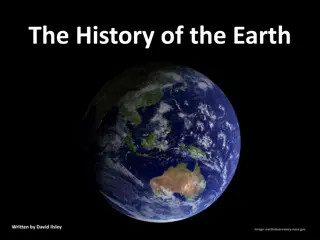
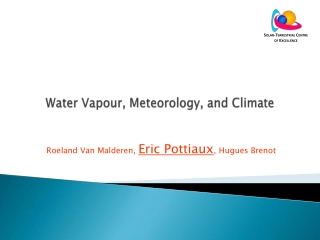
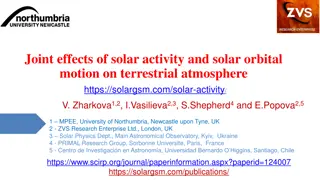

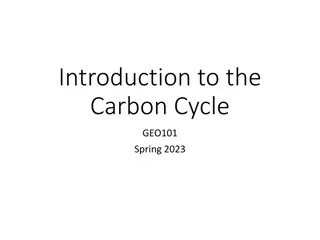





![READ⚡[PDF]✔ Solar Sailing: Technology, Dynamics and Mission Applications (Spring](/thumb/21622/read-pdf-solar-sailing-technology-dynamics-and-mission-applications-spring.jpg)







